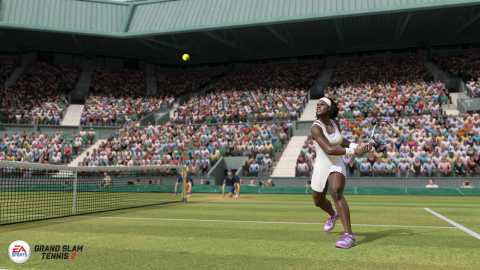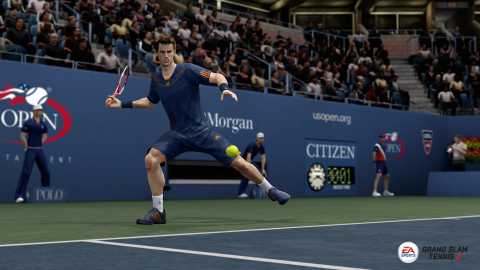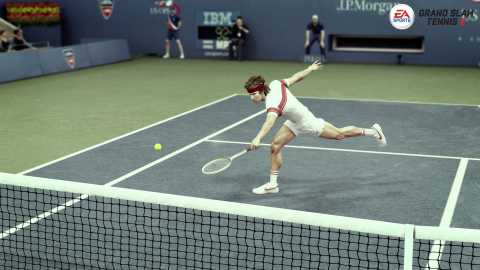
The name might lead you to believe otherwise, but it doesn’t take much time with EA Sports’ Grand Slam Tennis 2 to realize that this is a first-generation product, one that owes significantly more to Sega’s Virtua Tennis than the original, Wii-exclusive Grand Slam Tennis from a few years back. Sure, the evolution of the Virtua Tennis games has become, shall we say, subtle, over the past few years, yet Grand Slam Tennis 2 still can’t quite break out of that decade-plus shadow. It’s a decent start, but EA Sports still has some iterating to do before it’ll have a genuine competitor.
Though it trades the Japanese arcade gloss and crystalline guitars of Virtua Tennis in favor of EA Sports’ bloodless house style, the most meaningful differentiator in Grand Slam Tennis 2 lies in the controls. By default, the game attempts to map all of your racquet mechaniques to the right stick, and you’ll push the right stick down and up at various angles and with varying timing to serve and perform the flat, slice, top-spin, drop, and lob shots that make up your arsenal of moves.
While the underlying intent of the right-stick controls that EA Sports is so damn fond of is to create a more tactile connection to the on-screen action, the irony here is that it ends up feeling more complicated and mechanical. After spending some quality time being yelled at by resident pro John McEnroe in the tutorial--a must your first time in--I spent my first several hours with Grand Slam Tennis 2 with these right-stick controls. I wouldn’t say I struggled with them, but my performance improved immensely once I switched to the familiar face-button controls. Don’t chalk my preference entirely up to familiarity, though; it’s simply easier to perform with the precision of timing and aiming afforded by button presses, rather than the comparatively long throws and vague sense of position offered by the right stick.

Digging into Grand Slam Tennis 2’s nest of menus, it’s hard to shake the sense that you’re playing “EA Sports Presents: A Sport,” with options that are bland, predictable, and limited. You can play singles and doubles on real courts like Wimbledon or generic EA Sports-branded courts, you can set up tournaments, you can play online. The game is well-stocked with male and female pros, both current and classic, though there’s not much personality beneath the likenesses. Even the character creator, which features EA Sports’ patent-pending horrible monster generator better known as Game Face, feels like it was cut whole-cloth out of the Tiger Woods series.
There are some interesting challenges in the game’s Classics mode, which sticks you in a series of real and fantasy scenarios from the past 30 years of pro tennis. The career mode, though, represents the bulk of Grand Slam Tennis 2’s bid at longevity, letting you take your custom tennis pro through a 10-year career. Though there’s no visualized calendar, you can feel time tick by with each event, which invariably boils down to either a bland training exercise, a one-off exhibition match, a pre-tournament, or a proper, bracketed-and-branded tournament like the Australian Open, US Open, or Wimbledon. With little-to-no variety in the actual career action, monotony kicks in quick. Even when playing on an elevated difficulty level, I was consistently steamrolling the competition well into my second year. I could complain more about the career mode’s ill-conceived player progression, which doles out points inconsistently and feels largely disconnected from the XP system, if I wasn’t so consistently crushing the competition regardless.

The closest that Grand Slam Tennis 2 gets to having a personality comes from commentators Pat Cash and John McEnroe. At first, there’s a real casual, familiar charm to the way Cash sets up McEnroe’s long-form insights into your play style. It doesn’t feel scripted, and the expertise seems valid. The recorded material starts repeating itself almost immediately, to the point that it’s not uncommon to hear the same bits about playing deep and match point strategies several times over a single match, scuffing off any sense of naturalism almost immediately. Other quirks, such as the ability to play against Cash or McEnroe while they simultaneously provide commentary, reinforce the sense that the team behind Grand Slam Tennis 2 is still just getting its footing.
It’s damn hard to talk about video game tennis without bringing up Virtua Tennis, particularly when a game, like Grand Slam Tennis 2, hems so close to that original arcade formula. It’s a facsimile that’s executed well enough; there just aren’t any good reasons to recommend Grand Slam Tennis 2 over the games that it cribs from.